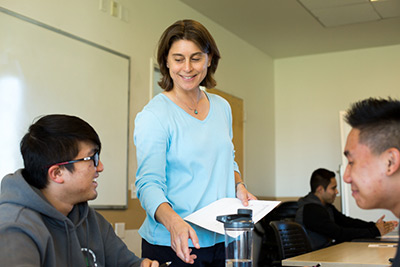
Professor Ashlie Martini works with some of her Design Thinking students.
That’s why mechanical engineering Professor Ashlie Martini has launched a pilot class to see if using case studies can help engineering students tackle complex design challenges.
“Students sometimes don’t know how to approach engineering problems that have open-ended solutions, or no solutions at all — as is often the case in practice,” Martini said. “We’re going to teach them methods for thinking like engineers.”
The goal is to use case studies to introduce “design thinking” to students to help them transition from classroom and lab-based learning to capstone design and, ultimately, into careers in engineering.
While the approach can be useful for all students, Martini said those who don’t have any previous background in engineering or much exposure to the topic will find it especially helpful.
Without being able to understand how to approach such problems, students were having difficulty with the capstone program, in which senior engineering students team up with companies and organizations from the region to find solutions to real-world challenges.
Under a National Science Foundation grant, Martini and Professor Aman Yadav, with the College of Education at Michigan State University, created the Design Thinking course at UC Merced, which uses case studies based on actual design problems to help students learn and practice thinking through engineering solutions.
Because she’s the one of the few students in the School of Engineering’s Design Thinking class who has already taken the capstone course, Karen Turcios can be especially helpful to Martini and to her fellow students, Martini said.
“Capstone has been the only course I've taken that really forced me to think about real-life situations,” Turcios said. “Through that, I learned a whole different set of skills.”
However, capstone was somewhat frustrating for her and her teammates, she said. Although they learned a lot through the course, they also spent much of the time just learning how to approach a problem, when they could have spent the time designing a better solution for their client.
“I think this class can help students reach solutions at much earlier stages of their projects so they don't have to go in circles like we did, and then have to rush for the last half of the semester to finalize the best solutions,” Turcios said. “I think taking this class first will help students come up with much, much better solutions in capstone.”
Yadav traveled to UC Merced at the beginning of the fall semester to give a guest lecture to kick off the new class, which is also a lesson for Martini in a new way of teaching.
Yadav examines how case studies can be used to expose students to ill-structured problems practicing engineers often face. He said his previous work has shown that case-based instruction can significantly enhance students’ conceptual learning and problem-solving.
“It also increases student engagement when they can see the real-world applications of what they are learning,” he said.
Students Assessing Teaching and Learning (SATAL), a service offered by the Center for Engaged Teaching & Learning, is involved with the class. SATAL will survey the 30 students during and after the course to see the direct effects it has on the students now, as well as the longer-term and wider-reaching effects as they apply what they have learned in capstone and beyond.
Lorena Anderson

Senior Writer and Public Information Representative
Office: (209) 228-4406
Mobile: (209) 201-6255






